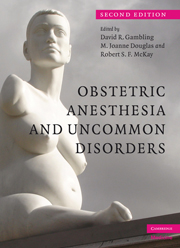Book contents
- Frontmatter
- Contents
- List of plates
- List of contributors
- Preface
- Section 1 Cardiovascular and respiratory disorders
- 1 Structural heart disease in pregnant women
- 2 Disorders of cardiac conduction
- 3 Vascular diseases
- 4 Respiratory disorders in pregnancy
- Section 2 Musculoskeletal disorders
- Section 3 Nervous system disorders
- Section 4 Metabolic disorders
- Section 5 Other disorders
- Index
- Plate Section
- References
4 - Respiratory disorders in pregnancy
from Section 1 - Cardiovascular and respiratory disorders
Published online by Cambridge University Press: 19 October 2009
- Frontmatter
- Contents
- List of plates
- List of contributors
- Preface
- Section 1 Cardiovascular and respiratory disorders
- 1 Structural heart disease in pregnant women
- 2 Disorders of cardiac conduction
- 3 Vascular diseases
- 4 Respiratory disorders in pregnancy
- Section 2 Musculoskeletal disorders
- Section 3 Nervous system disorders
- Section 4 Metabolic disorders
- Section 5 Other disorders
- Index
- Plate Section
- References
Summary
Adult respiratory distress syndrome
Epidemiology
Adult respiratory distress syndrome (ARDS) is a severe form of acute respiratory failure that can develop following a systemic or pulmonary insult. Adult respiratory distress syndrome is not unique to adults, and in children is known as “acute respiratory distress syndrome”. The incidence of ARDS in pregnancy is variably reported as 1 in 3000 to 1 in 6000 deliveries with mortality as high as 44%.
Etiology
Several disorders can cause ARDS in pregnancy (see Table 4.1). Sepsis, secondary to pyelonephritis, chorioamnionitis, or endometritis, is a common cause of ARDS in pregnancy. Other causes include obstetric hemorrhage, severe preeclampsia, and aspiration. There may be a combination of sepsis, shock, and fluid overload, the latter of which can be exacerbated by tocolytic therapy.
Pathophysiology
Following the initial insult, a number of inflammatory mediators such as tumor necrosis factor and interleukins 1, 6, and 8 are released. Neutrophils are activated to release other mediators such as reactive oxygen (O2) species and proteases. These mediators produce widespread microvascular and alveolar epithelial damage. Microvascular damage leads to increased capillary permeability and subsequent interstitial and alveolar edema. Alveolar damage results in loss of surfactant and subsequent alveolar collapse. Alveolar edema and collapse contribute to ventilation–perfusion (V/Q) mismatching and intrapulmonary shunting with subsequent hypoxemia.
Pulmonary hypertension frequently develops leading to right ventricular (RV) dysfunction which reduces left ventricular (LV) preload and cardiac output (CO). Depressed CO further compromises O2 delivery.
- Type
- Chapter
- Information
- Obstetric Anesthesia and Uncommon Disorders , pp. 75 - 100Publisher: Cambridge University PressPrint publication year: 2008

